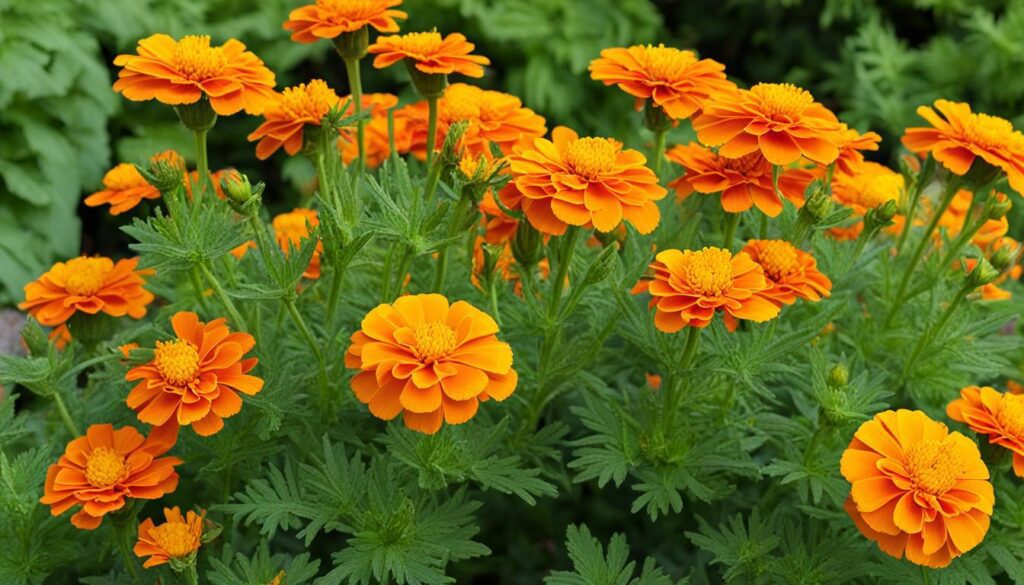Marigolds are beloved flowers known for their vibrant colors and versatility in gardens. If you’re considering adding marigolds to your garden, you may be wondering whether they are annual or perennial plants. The answer is both! While most marigold varieties are grown as annuals, there are also perennial types available. Let’s explore the nature of marigolds and how you can incorporate them into your garden.
Key Takeaways:
- Marigolds can be both annuals and perennials, depending on the variety.
- The commonly planted French and African marigolds are considered annuals but often self-seed.
- Perennial marigolds, such as Mexican marigolds, can be ordered online and are native to Mexico and the American Southwest.
- Marigolds prefer full sun but can tolerate some partial shade, especially in hot climates.
- Marigolds are generally low-maintenance and can attract pollinators.
Annual Marigolds: French and African Varieties
French marigolds (Tagetes patula) and African marigolds (Tagetes erecta) are the most commonly grown annual varieties of marigolds. These plants sprout, grow, flower, and die all in the same year. However, they often self-seed, meaning their seeds drop to the ground, overwinter, and germinate in the spring without any assistance. This self-seeding behavior can make them appear to be perennial, but they are actually annuals.
Some hybrid marigolds are sterile and won’t produce viable seeds, while open-pollinated varieties can self-seed more reliably. Marigold seeds can be sown directly in the ground or started indoors and transplanted. They prefer full sun but can tolerate partial shade, especially in hot climates. Marigolds are generally low-maintenance and can attract pollinators. They are also sometimes used as edible garnishes.
Why Choose Annual Marigolds
Annual marigolds, such as French and African varieties, are a popular choice for gardeners due to their vibrant colors, easy care, and ability to attract pollinators. Their ability to self-seed allows them to come back year after year, adding a touch of beauty to your garden without much effort. Whether you’re looking to fill flower beds, create container gardens, or add pops of color to your landscape, annual marigolds are a versatile and reliable choice.
Tips for Growing Annual Marigolds
- Choose a sunny location for planting, as annual marigolds thrive in full sun.
- Prepare the soil by removing weeds and adding organic matter to improve drainage.
- Sow marigold seeds directly in the ground after the last frost or start them indoors 4-6 weeks before the last frost for earlier blooms.
- Water the plants regularly, keeping the soil moist but not waterlogged.
- Deadhead faded flowers to encourage continuous blooming.
- Monitor for pests such as aphids or caterpillars and take appropriate action if necessary.
Perennial Marigolds: Mexican and Other Varieties
While most marigolds are annuals, there are also perennial varieties that can bring long-lasting beauty to your garden. One such perennial marigold is the Mexican marigold (Tagetes lemmonii). This stunning shrub can reach heights of up to 6 feet and is hardy in USDA Zones 8 to 11. Its vibrant yellow flowers and aromatic foliage make it a standout choice for any landscape. Another perennial option is the mountain marigold (Tagetes palmeri), a semi-evergreen shrub that grows to about 3 feet tall and thrives in Zones 8 to 10. Its daisy-like flowers and feathery foliage create a graceful display.
Another perennial variety to consider is the Mexican mint marigold (Tagetes lucida), also known as Mexican tarragon. This smaller perennial reaches heights of 1 to 3 feet and boasts beautiful clusters of golden-yellow flowers. Mexican mint marigold is not only valued for its ornamental appeal but also for its culinary uses. The leaves of this marigold species have a licorice-like flavor and are often used as a substitute for tarragon in cooking and teas.
“Perennial marigolds, such as the Mexican marigold, mountain marigold, and Mexican mint marigold, add a touch of elegance and versatility to any garden. Their vibrant flowers and distinctive scents make them a delightful choice for both visual appeal and culinary enjoyment.” – Landscaping Enthusiast
Perennial marigolds can be harder to find at local garden centers, but they can be ordered online from specialty nurseries. When purchasing marigold seeds, you can choose from various quantities and start them indoors or directly sow them in the ground. Perennial marigolds thrive in full sun but can tolerate some partial shade, especially in hot climates. With their longevity and resilience, perennial marigolds are a wonderful addition to any garden, providing years of beauty and fragrance.
Growing and Care Tips for Marigolds
Marigolds are a popular choice for gardeners due to their vibrant colors and easy care. Whether you’re a beginner or an experienced gardener, these tips will help you successfully grow and care for your marigold plants.
Choosing the Right Location
Marigolds thrive in full sun, so choose a location in your garden that receives at least six hours of direct sunlight each day. They can tolerate some partial shade, especially in hot climates, but the more sun they get, the more flowers they will produce. Ensure that the soil is well-drained to prevent waterlogging, as marigolds prefer slightly dry conditions.
Watering and Fertilizing
Marigolds have moderate water needs and should be watered regularly. Allow the soil to dry out slightly between waterings to prevent overwatering, which can lead to root rot. It’s best to water marigolds at the base of the plants rather than overhead to avoid wetting the foliage. Applying a balanced fertilizer once a month can help promote healthy growth and abundant blooms.
Deadheading and Pest Control
Deadheading, or removing faded flowers, can encourage continuous blooming and prevent the plants from going to seed too quickly. Simply pinch off the spent blooms with your fingers or use gardening shears. Marigolds are generally resistant to pests and diseases, but if you notice any signs of infestation, such as aphids or spider mites, you can control them by spraying the plants with a mild insecticidal soap or using natural predators like ladybugs.
With these simple tips, you can enjoy the beauty of marigolds in your garden while maintaining their health and vitality. Whether you’re growing them as annuals or perennials, marigolds are a versatile and colorful addition to any landscape.
Benefits and Uses of Marigolds
Marigolds offer a range of benefits and have various uses that make them a valuable addition to any garden. Here are some of the key advantages and ways you can utilize marigolds:
Pest-Repellent Properties
Marigolds are known for their pest-repellent properties, particularly against nematodes, which are tiny parasitic worms that can harm plant roots. Certain varieties, like the French marigold, release a chemical that repels these pests, making them a natural and effective form of pest control. Planting marigolds around your garden can help protect your other plants from nematode damage.
Attract Pollinators
Marigold flowers are attractive to bees and butterflies, making them excellent for attracting pollinators to your garden. By planting marigolds, you can create a welcoming environment for these vital insects, promoting pollination and supporting the overall health and biodiversity of your garden.
Colorful Display and Cut Flowers
With their vibrant blooms in shades of yellow, orange, and red, marigolds add a burst of color to flower beds and borders. They can create eye-catching displays, adding visual interest and beauty to your garden. Additionally, marigolds make stunning cut flowers, bringing their cheerful colors indoors and brightening up any room.
Edible Garnishes and Cultural Significance
Some varieties of marigolds, like the signet marigold, have a slightly spicy flavor and can be used as edible garnishes in cooking. They can add a unique touch to salads, soups, and various dishes, enhancing both the taste and presentation. Moreover, marigolds hold cultural significance in different traditions and ceremonies. They are believed to bring good luck and are often used as decorations at weddings and religious events.
Conclusion
Marigold flowers can be both annual and perennial, offering versatility in your garden. While most marigolds are grown as annuals, some varieties, such as the Mexican marigold and mountain marigold, are perennials. These perennial marigolds can self-seed, giving them a perennial-like appearance. Whether you choose annual or perennial marigolds, they are a beautiful addition to any garden.
Growing and caring for marigolds is relatively easy. They prefer full sun and well-drained soil. Marigolds can attract pollinators, add vibrant colors to your garden, and even repel certain pests. Additionally, certain marigold varieties, like the signet marigold, can be used as edible garnishes in cooking.
Whether you’re a novice or experienced gardener, marigolds are a great choice. They are low-maintenance, drought-tolerant once established, and can bring a touch of beauty and nature to your outdoor space. Whether you’re planting them as annuals or perennials, follow these gardening tips to ensure your marigolds thrive: provide them with sufficient sunlight, well-drained soil, and regular watering.
Are Marigold Flowers Considered Perennial or Annual in Their Growth Cycle?
Marigold flowers are considered annuals in their growth cycle, meaning they complete their life cycle in one year. However, with the right conditions, some varieties can act as perennials in warmer climates. This marigolds growth cycle discovery has allowed gardeners to enjoy these vibrant flowers for multiple years.
FAQ
Are marigold flowers annual or perennial?
Marigold flowers can be both annual and perennial, depending on the variety.
Which varieties of marigolds are considered annuals?
French marigolds (Tagetes patula) and African marigolds (Tagetes erecta) are the most commonly grown annual varieties of marigolds.
Do marigolds self-seed?
Yes, marigolds often self-seed, meaning their seeds drop to the ground, overwinter, and germinate in the spring without any assistance.
Are there perennial varieties of marigolds?
Yes, there are perennial varieties of marigolds, such as the Mexican marigold (Tagetes lemmonii), mountain marigold (Tagetes palmeri), and Mexican mint marigold (Tagetes lucida).
How should marigold seeds be sown?
Marigold seeds can be directly sown in the ground or started indoors and transplanted.
What growing conditions do marigolds prefer?
Marigolds prefer full sun but can tolerate partial shade, especially in hot climates.
How should marigolds be cared for?
Marigolds should be watered regularly, and the soil should be kept lightly moist, not wet. Deadheading, or removing faded flowers, is not necessary but can encourage prolonged blooming. Mulching can help suppress weeds.
Can marigolds attract pollinators?
Yes, marigolds can attract pollinators such as bees and butterflies.
What are the benefits and uses of marigolds?
Marigolds can add color to flower beds, be used as cut flowers, have pest-repellent properties, and are sometimes used as edible garnishes in cooking.












